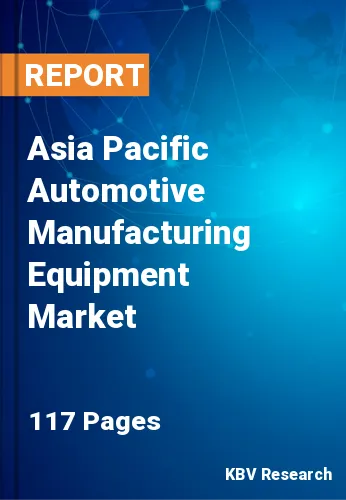The Asia Pacific Automotive Manufacturing Equipment Market would witness market growth of 11.0% CAGR during the forecast period (2023-2030).
AI is used to model and simulate production lines, machinery, and equipment and to increase the production process's overall throughput. AI enables production simulation to go beyond a static simulation of a predetermined process scenario to dynamic simulations that can adapt to fluctuations in the state of materials and machinery and modify simulations. These simulations can then be utilized to modify production processes in real-time.
3D printing to fabricate production parts is now standard practice in the automotive sector. Various (additive manufacturing) AM-fabricated elements are incorporated into the assembly of most vehicles manufactured today. This includes engine components, gearboxes, gears, brake components, headlamps, body kits, bumpers, gasoline tanks, grilles, fenders, and frame construction. In addition, some automakers are printing entire bodies for small electric vehicles.
Automotive Manufacturing will be notably significant for the expanding EV industry regarding weight reduction. While this has always been desirable for conventional internal combustion engine (ICE) vehicles to improve fuel efficiency, it is now more essential than ever because a lighter weight can result in significantly longer battery life between charges. The weight-to-strength ratio of automobile components designed specifically for AM fabrication can be drastically enhanced. Almost all vehicle components can now be made lighter through additive manufacturing as opposed to the use of metals.
China's domestic automobile production will exceed 35 million units. More than 25 million vehicles, including 19.9 million automobiles, were sold in 2020. An increase in vehicle sales facilitates an increase in auto maintenance products. However, even during COVID-19, the Chinese government implemented several measures to encourage automobile usage. These initiatives include delaying the implementation of the China Six Emission Standard until January 2021, providing fiscal and tax assistance, expediting the phase-out of obsolete diesel trucks, and expanding channels for trading used vehicles. Government assistance and the high demand will increase vehicle production and sales, creating new growth opportunities for automotive manufacturing equipment and spurring regional market expansion.
The China market dominated the Asia Pacific Automotive Manufacturing Equipment Market by Country in 2022, and would continue to be a dominant market till 2030; thereby, achieving a market value of $1,383.1 Million by 2030. The Japan market is exhibiting a CAGR of 10.3% during (2023 - 2030). Additionally, The India market would showcase a CAGR of 11.7% during (2023 - 2030).
Based on Mode of Operation, the market is segmented into Automatic, and Semi-Automatic. Based on Equipment Type, the market is segmented into Robot, CNC Machine, Conveyor Belt, Stamping Machine, Welding Machine, and Injection Molding Machine. Based on Vehicle Type, the market is segmented into Commercial Vehicles, and Passenger Vehicles. Based on countries, the market is segmented into China, Japan, India, South Korea, Singapore, Malaysia, and Rest of Asia Pacific.
Free Valuable Insights: The Worldwide Automotive Manufacturing Equipment Market is Projected to reach USD 13.3 Billion by 2030, at a CAGR of 10.6%
The market research report covers the analysis of key stake holders of the market. Key companies profiled in the report include ABB Ltd, FANUC Corporation, Kuka AG (Midea Group Co., Ltd.), Daifuku Co., Limited, Yaskawa Electric Corporation, Kawasaki Heavy Industries, Ltd., Amada Co., Ltd., Schuler Group GmbH (Andritz Group), Universal Robots A/S (Teradyne, Inc.) and TRUMPF SE + Co. KG.
By Mode of Operation
By Equipment Type
By Vehicle Type
By Country
Our team of dedicated experts can provide you with attractive expansion opportunities for your business.

